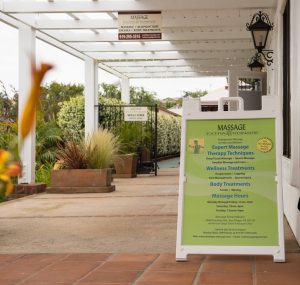Myofascial release is becoming more known as people are experiencing the benefits of receiving this treatment. ‘Myo’ refers to muscle and ‘fascia’ refers to the material covering the muscle, so myofascial release is the process of loosening the tightness of the tissue. As you can see in the image below, the fascia surrounds the muscle fibers and also attaches itself in between the fibers.
This covering protects the muscle and keeps it in it’s place. Fascia is throughout the entire body from head to toe. When there is tension due to daily activities, injury or emotional strain, the body’s response is to send extra fascia tissue to the area to help support it. This tissue is sticky and referred to as an adhesion, which allows it to stick to the area in need. The less hydrated the system is, the more sticky the adhesions becomes. Eventually this leads to the feeling of having knots as the adhesions collect and become clumped together in stickiness. This can lead to reduced range of motion, stiffness and irritated nerves.
Now that you know what that crunchy bumpy sensation is that is experienced during a massage, let’s explore ways to make it better by returning range of motion as we loosen tight muscles and relieve discomfort. Below is a good start:
- Myofascial Release Massage
- Light Static Stretches
- Moist Heat
- Gentle Exercise
- Drink More Water
Myofascial Release is a massage technique that involves the process of working the extra adhesions loose, so that they can be flushed into the circulatory system and removed. When the muscle is set free from the extra tightening fascia, it improves mobility and feels relaxed. If the nerves have been squeezed and are hurting, overtime they will feel better once the grip of excess fascia tissue is removed. Sometimes nerve discomfort dissipates as soon as the muscle is released, but often nerves take additional time to calm down once they are aggravated. Healing nerve pain can be a slow process.
Lightly stretching the muscle is also helpful to release the tightness of the excess fascia. Always warm up 5-10 minutes with a gentle exercise like walking or biking before stretching. Stretching a cold muscle increases the likelihood of injury. It is important not to stretch to the point of pain, but only to the point of light resistance. This should be a feel-good stretch. Hold a static stretch at least 30 seconds without bouncing to reduce the chance of pulling or tearing a muscle. Repeat several times and try to do this routine everyday.
Heat is a great way to relax the muscle and increase circulation. Increased circulation enhances the tissue’s natural healing process. As the muscle loosens, some of the adhesions that aren’t too stuck to it will be released. Moist heat such as a hot bath or jacuzzi is wonderful to loosen up the muscles. This is a great time to do a light stretch.
Exercise warms up the body, which loosens up the adhesions allowing them to escape. It also increases circulation throughout the system, maximizing the flushing out of unwanted cellular waste that accumulates when adhesions are released. Try something gentle like swimming, walking or stationary cycling to begin with and work your way up to more difficult challenges as you feel your range of motion normalize and are pain free.
Water is key to helping the body flush out released adhesions, as well as contributing a multitude of other circulatory benefits. The less hydrated you are, the more viscosity exists, which means that your system is slowed down due to the thickness of the fluids trying to travel through to the correct places to be filtered out. It is always important to be sufficiently hydrated, but more so when you are intentionally releasing excess debris into your system. The last thing that you need is a bunch of cellular waste sitting stagnant, causing your immune system to struggle with the overload. This is why massage therapists will usually encourage clients to drink extra water after a session. Keeping the fluids moving is vital, so that things don’t get backed up in the lymph system. (See last month’s blog for a run-down on that).
Water is key to helping the body flush out released adhesions, as well as contributing a multitude of other circulatory benefits. The less hydrated you are, the more viscosity exists, which means that your system is slowed down due to the thickness of the fluids trying to travel through to the correct places to be filtered out. It is always important to be sufficiently hydrated, but more so when you are intentionally releasing excess debris into your system. The last thing that you need is a bunch of cellular waste sitting stagnant, causing your immune system to struggle with the overload. This is why massage therapists will usually encourage clients to drink extra water after a session. Keeping the fluids moving is vital, so that things don’t get backed up in the lymph system. (See last month’s blog for a run-down on that).
Often people walk around with so much tightness and loss of range of motion for so long, that they don’t know how bad it is until it’s finally released. It is very common for people to walk out of the massage room moving their head around in amazement with how good it feels to once again be able to freely move without pain and stiffness.
The best way to maximize myofascial release is to combine all five techniques of massage, exercise, stretching, water and heat therapy.
Stay healthy, Stay happy!
We are located inside the beautiful San Diego Tennis and Racquet Club.
Our rooms overlook the pool area.

San Diego Tennis and Racquet Club
4848 Tecolote Rd. San Diego, Ca
Appointments (619) 295-3516
1sdmassage@gmail.co
1sdmassage@gmail.co



